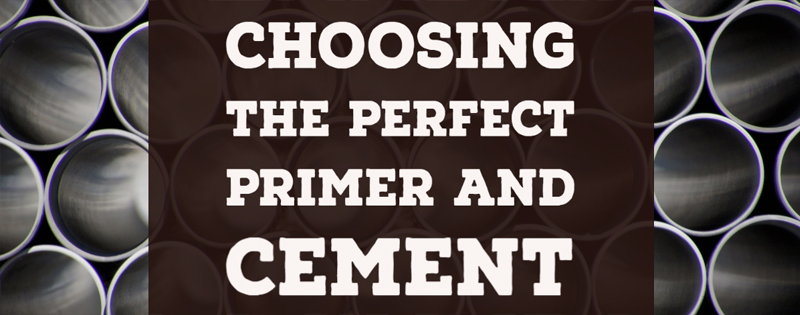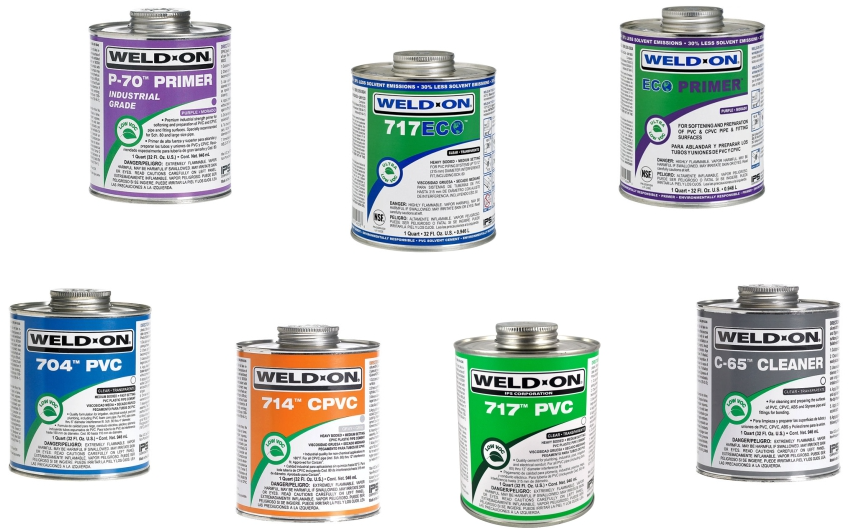Choosing the perfect primer and cement

Recently on our blog we covered the best practices for gluing PVC fittings with solvent cement, ensuring a lasting bond for your project. In this week's blog post, we're going to cover which type of solvent cement and primer you should use for the material on your project. Please keep in mind that projects using compressed air or gasses should not use solvent cement.

Types of PVC Primers
PVC Primers are applied to pipe and fittings to soften the PVC in anticipation of solvent welding. Primers come in two different body types: medium body and heavy (or industrial) body primers. For Schedule 40 PVC pipe and fittings, medium body primers are typically used; heavy body primers can be used, but come with an additional cost. For large diameter Schedule 40 fittings, it is recommended to incur the additional cost of the heavy body primer to ensure the larger wall-thickness is adequately primed. For Schedule 80 PVC pipe and fittings, you should always use the heavy body cement due to the increased wall thickness. For CPVC pipe and fittings, heavy body primer is always required.
In addition to the different body types, primers come in two different colors: clear and purple. Purple primers are used in industrial applications to expedite the inspection process; inspectors must perform a visual check of each joint to ensure it has been properly primed -- the purple color can greatly speed up this process. Clear primers are used in residential applications where aesthetics are more important than the speed of inspection, ensuring that the joint looks clean and tidy.
Types of Solvent Cement
As you may have guessed from the blog's title, there are multiple different types of solvent cement. For Schedule 40 and Schedule 80 PVC, there are three different grades of solvent cement: medium body, heavy body, and extra heavy body. For medium and heavy body cement, users have a choice between gray and clear for the color; heavy body cement is only available in gray. For CPVC fittings, there is only one type of cement, which is a gray color.
Choosing the right Primer and Cement
Now that we've learned the basics about primers and cements, we need to dive into the specifics to ensure we're picking the correct products for our application. Below is a step by step guide for choosing the right primer and cement.
Choosing the right PVC Primer
Step 1: What material am I using?
For Schedule 40 fittings , we can use either medium or heavy body primers. For Schedule 80 and CPVC fittings, you will need the industrial or heavy grade primer.
Step 2: What diameter is my PVC?
In Step 1, we mentioned that Schedule 40 pipe and fittings can require either a medium or heavy body primer; the wall thickness of the fitting determines which should be used. At 6" diameter or greater, it is required that you use heavy primer, but you can use the industrial body primer at any thickness without issue.
Step 3: What color should I get?
As we mentioned previously in the article, primers come in two colors: clear and purple. If your job is being inspected upon completion, it's recommended (and in some cases required) to use the visible, purple primer. If your job isn't being inspected, it's completely at your discretion; many people prefer the clear primer for cosmetic purposes.
Choosing the right Solvent Cement
Step 1: What material am I using?
Choosing the right solvent cement involves almost all the same factors as choosing the right primer. For Schedule 40 fittings, both medium and heavy body cements can be used. For Schedule 80 fittings, can use medium body or heavy body cements, but only for a narrow range of diameters. CPVC fittings must use their own, unique solvent cement.
Step 2: What diameter is my PVC?
For Schedule 40 PVC, medium body solvent cements can be used to glue fittings up to 6" in diameter; after that point, heavy body solvent cements are required. For extremely large diameter pipe and fittings (14"+), extra heavy body solvent cement is required. For Schedule 80 pipe and fittings, medium body can be used for up to 4" diameters. For diameters 4" to 12", heavy body solvent cement is required. For Schedule 80 fittings greater than 12" in diameter, extra heavy solvent cement is required
Primers and Solvent Cement: A Review
In today's article, we covered everything about the different types of solvent cements and their use cases. At Drainage Connect, we carry both quarts and gallons of primer and cement; typically speaking, you need half as much primer as you'll need glue. Below you can see the typical dry times and set times for the different types of solvent cement.

If you've got any questions about how to choose the right primer and cement, leave them below. If you liked this article, please check out more of our content, including these great related blog posts below. As always, be sure to like and subscribe to us on Facebook, Instagram, Pinterest, or Twitter to keep apprised of the latest and greatest in drainage technology as well as get the latest exclusive deals! If you're making your first purchase, sign up for the newsletter to get a 1-time-use 5% off coupon!















Comments
We have Hardie Board for the siding around our house including the chimney which is only for a gas stove. We have used Benjamin Moore acrylic AURA for the whole house. Only the chimney area is where the paint will